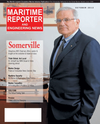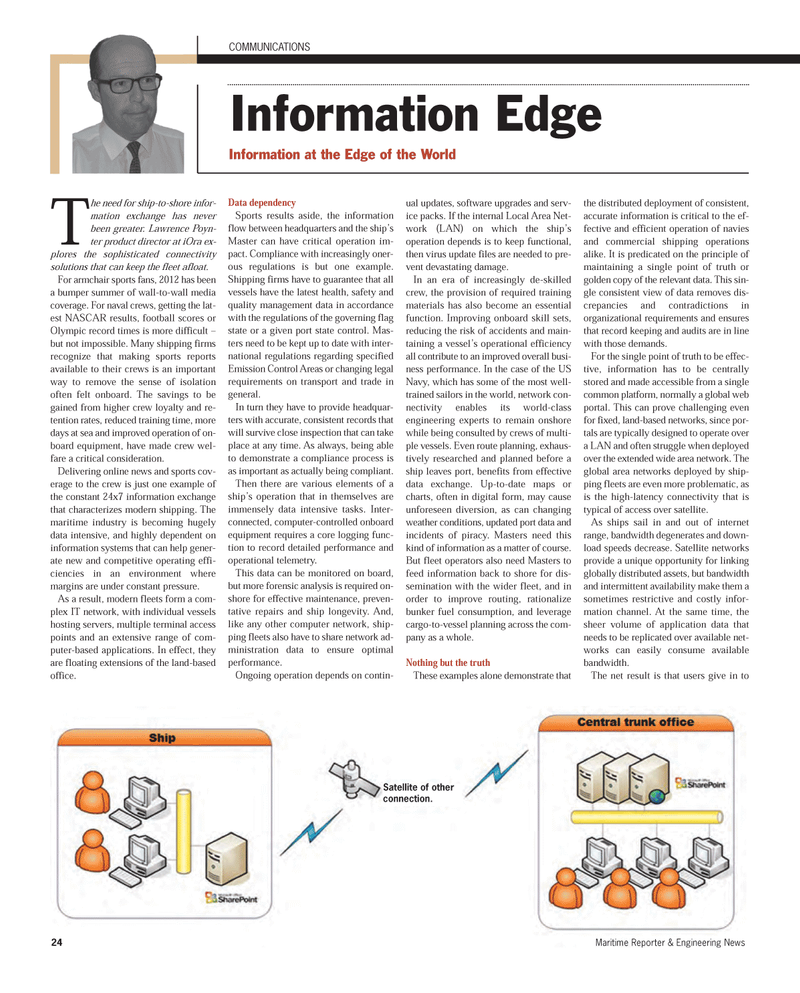
Page 24: of Maritime Reporter Magazine (October 2012)
Marine Design & Construction
Read this page in Pdf, Flash or Html5 edition of October 2012 Maritime Reporter Magazine
24Maritime Reporter & Engineering News The need for ship-to-shore infor- mation exchange has never been greater. Lawrence Poyn- ter product director at iOra ex- plores the sophisticated connectivity solutions that can keep the fleet afloat. For armchair sports fans, 2012 has been a bumper summer of wall-to-wall media coverage. For naval crews, getting the lat- est NASCAR results, football scores or Olympic record times is more difficult ? but not impossible. Many shipping firms recognize that making sports reportsavailable to their crews is an important way to remove the sense of isolation often felt onboard. The savings to be gained from higher crew loyalty and re- tention rates, reduced training time, moredays at sea and improved operation of on- board equipment, have made crew wel- fare a critical consideration. Delivering online news and sports cov- erage to the crew is just one example of the constant 24x7 information exchange that characterizes modern shipping. The maritime industry is becoming hugelydata intensive, and highly dependent on information systems that can help gener- ate new and competitive operating effi- ciencies in an environment where margins are under constant pressure. As a result, modern fleets form a com-plex IT network, with individual vessels hosting servers, multiple terminal access points and an extensive range of com- puter-based applications. In effect, they are floating extensions of the land-based office. Data dependencySports results aside, the informationflow between headquarters and the ship?s Master can have critical operation im- pact. Compliance with increasingly oner- ous regulations is but one example. Shipping firms have to guarantee that all vessels have the latest health, safety and quality management data in accordancewith the regulations of the governing flag state or a given port state control. Mas- ters need to be kept up to date with inter- national regulations regarding specified Emission Control Areas or changing legal requirements on transport and trade ingeneral. In turn they have to provide headquar- ters with accurate, consistent records thatwill survive close inspection that can take place at any time. As always, being able to demonstrate a compliance process isas important as actually being compliant.Then there are various elements of a ship?s operation that in themselves are immensely data intensive tasks. Inter- connected, computer-controlled onboard equipment requires a core logging func-tion to record detailed performance andoperational telemetry. This data can be monitored on board,but more forensic analysis is required on- shore for effective maintenance, preven- tative repairs and ship longevity. And, like any other computer network, ship- ping fleets also have to share network ad- ministration data to ensure optimalperformance. Ongoing operation depends on contin-ual updates, software upgrades and serv- ice packs. If the internal Local Area Net- work (LAN) on which the ship?s operation depends is to keep functional, then virus update files are needed to pre- vent devastating damage. In an era of increasingly de-skilledcrew, the provision of required training materials has also become an essentialfunction. Improving onboard skill sets, reducing the risk of accidents and main-taining a vessel?s operational efficiency all contribute to an improved overall busi- ness performance. In the case of the USNavy, which has some of the most well- trained sailors in the world, network con- nectivity enables its world-class engineering experts to remain onshore while being consulted by crews of multi- ple vessels. Even route planning, exhaus- tively researched and planned before a ship leaves port, benefits from effective data exchange. Up-to-date maps or charts, often in digital form, may causeunforeseen diversion, as can changing weather conditions, updated port data andincidents of piracy. Masters need this kind of information as a matter of course.But fleet operators also need Masters tofeed information back to shore for dis-semination with the wider fleet, and inorder to improve routing, rationalize bunker fuel consumption, and leverage cargo-to-vessel planning across the com- pany as a whole. Nothing but the truth These examples alone demonstrate that the distributed deployment of consistent, accurate information is critical to the ef-fective and efficient operation of navies and commercial shipping operationsalike. It is predicated on the principle of maintaining a single point of truth orgolden copy of the relevant data. This sin- gle consistent view of data removes dis- crepancies and contradictions inorganizational requirements and ensures that record keeping and audits are in line with those demands. For the single point of truth to be effec- tive, information has to be centrally stored and made accessible from a singlecommon platform, normally a global webportal. This can prove challenging even for fixed, land-based networks, since por- tals are typically designed to operate over a LAN and often struggle when deployed over the extended wide area network. The global area networks deployed by ship- ping fleets are even more problematic, as is the high-latency connectivity that is typical of access over satellite. As ships sail in and out of internetrange, bandwidth degenerates and down- load speeds decrease. Satellite networks provide a unique opportunity for linking globally distributed assets, but bandwidth and intermittent availability make them a sometimes restrictive and costly infor- mation channel. At the same time, the sheer volume of application data that needs to be replicated over available net- works can easily consume available bandwidth. The net result is that users give in to COMMUNICATIONS Information EdgeInformation at the Edge of the World Satellite of otherconnection.MR#10 (18-25):MR Template 10/4/2012 1:02 PM Page 24

 23
23

 25
25
